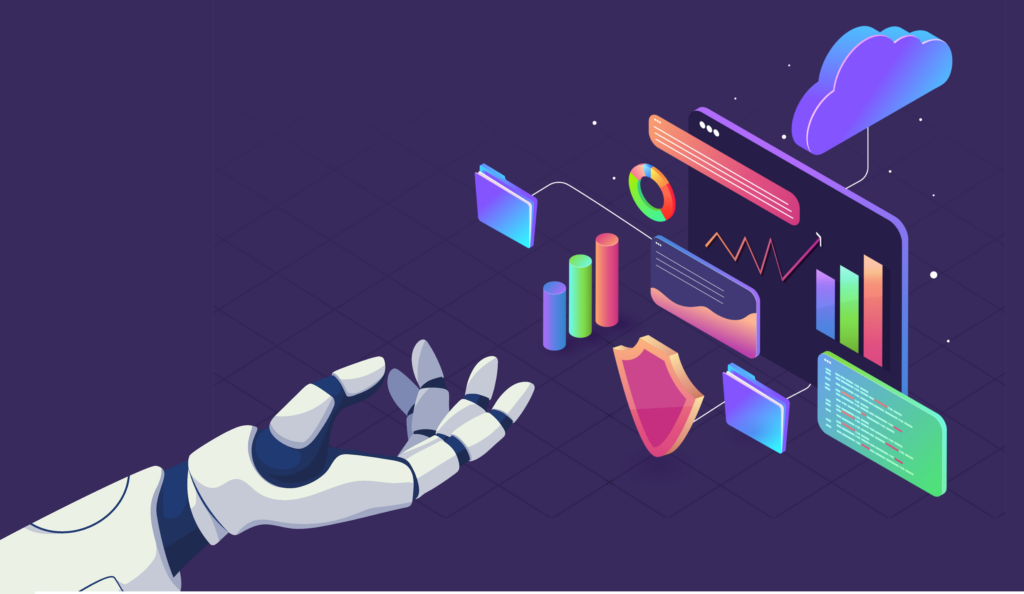Table of Content
- Understanding Artificial Intelligence: The Foundation of Machine Learning
- Deep Learning: The Power Behind AI Advancements
- Types of Deep Learning Models
- What is Generative AI?
- Exploring Transformers in Generative AI
- Pre-training and Fine-tuning: The Key to Generative AI
- Transformers & Generative AI: How They Work Together
- Prompt Engineering
- Model Types and Applications
- Foundation Models: The Backbone of Generative AI
- Open-Source Foundation Models: Expanding Accessibility
- Open Weight Models: Transforming Generative AI
- Code LLMs: Transforming Software Development
- Enhance LLMs with Retrieval Augmented Generation (RAG)
- AI Application Opportunities
- AI Development Services
The Evolution and Impact of Artificial Intelligence
Over the past few decades, Artificial Intelligence (AI) has evolved from a theoretical concept into a transformative force shaping industries, economies, and everyday life. From virtual assistants and autonomous vehicles to medical diagnostics and financial forecasting, AI is revolutionizing how humans interact with technology.
The idea of intelligent machines dates back to ancient myths and early mechanical devices, but AI as we know it began to take shape in the mid-20th century. Early pioneers such as Alan Turing and John McCarthy laid the foundation for AI research, envisioning machines capable of learning, reasoning, and problem-solving. However, it wasn’t until the explosion of computational power, big data, and advanced algorithms that AI started making real-world breakthroughs.
Today, AI is no longer confined to research labs. It powers search engines, recommendation systems, automated customer service, and even creative applications like music composition and art generation. As AI continues to advance, its ability to not only process information but also generate new content is reshaping industries and opening new possibilities.
This leads us to an essential question: How do AI systems learn, adapt, and evolve?
To answer that, we must explore Machine Learning (ML), the driving force behind modern AI.
Understanding Artificial Intelligence: The Foundation of Machine Learning
Artificial Intelligence (AI) is transforming the way machines interact with information, enabling them to reason, learn, and make decisions autonomously. AI systems, often referred to as intelligent agents, are designed to acquire knowledge, adapt to new data, and mimic human-like intelligence.
At the core of AI lies Machine Learning (ML), a subfield focused on teaching machines to recognize patterns from data rather than relying on rigid, rule-based programming. By processing vast amounts of information, ML models can make predictions, detect trends, and improve performance over time.
Exploring Machine Learning Varieties
- Supervised Learning – Models learn from labeled data, mapping inputs to known outputs to make accurate predictions. This method is widely used in image recognition, spam detection, and medical diagnosis because it provides clear, structured feedback for learning.
- Unsupervised Learning – Models analyze unlabeled data, identifying hidden patterns and structures without predefined categories. This approach is essential in clustering, anomaly detection, and customer segmentation, where the goal is to uncover insights without prior knowledge of classifications.
- Semi-supervised Learning – A hybrid approach that combines small amounts of labeled data with a large pool of unlabeled data, reducing the need for extensive manual labeling. It is particularly useful in domains like speech recognition and fraud detection, where obtaining labeled data can be expensive and time-consuming.
- Reinforcement Learning – Unlike other approaches, RL focuses on decision-making and learning through interaction. An agent takes actions in an environment and receives rewards or penalties as feedback, gradually improving its strategy to maximize long-term rewards. Modern AI systems, including Large Language Models (LLMs) like ChatGPT and DeepSeek-R1, use Reinforcement Learning from Human Feedback (RLHF) to enhance response quality and decision-making.
Deep Learning: The Power Behind AI Advancements
Deep learning, a specialized branch of machine learning, uses artificial neural networks to recognize complex patterns in data. It is called “deep” learning because it employs multi-layered neural networks, enabling AI systems to process and learn from vast amounts of information. These models have gained widespread popularity due to their success in computer vision, natural language processing, and autonomous systems.
Neural networks, inspired by the human brain’s structure, consist of interconnected layers of nodes (neurons) that process and analyze data. By leveraging multiple layers, deep learning models outperform traditional machine learning approaches in capturing intricate patterns. They can process both labeled and unlabeled data, extracting key features from labeled datasets while generalizing insights to new, unseen examples.
Types of Deep Learning Models
Discriminative Models (Classification & Prediction)
Discriminative models classify data or predict labels by learning the relationship between input features and their corresponding categories. Trained on labeled datasets, these models can accurately distinguish between different types of data.
Example: A spam filter that classifies emails as spam or not spam.
How it works: Discriminative models learn decision boundaries based on conditional probability, helping them differentiate between various data points.
Generative Models (Content Creation)
Generative models create new data by learning the patterns and distributions of their training datasets. Instead of simply classifying inputs, they generate realistic outputs that resemble the original data.
Example: AI-generated images, text (like GPT), and synthetic voice generation.
How it works: These models estimate the joint probability distribution of the data, allowing them to predict and generate new, coherent outputs.
The Shift Toward Generative AI
While traditional AI systems analyze and classify data, Generative AI takes intelligence a step further by creating entirely new content. This transition is driven by deep learning breakthroughs, larger datasets, and increased computational power.
Recent breakthroughs in deep learning have led to the development of powerful generative models such as GPT-4, Stable Diffusion, and Sora, enabling AI to go beyond analysis and actively create human-like text, realistic images, music, and even code. This advancement marks a fundamental shift in artificial intelligence—ushering in the era of Generative AI.
This brings us to the next frontier of artificial intelligence—Generative AI.
What is Generative AI?
Generative AI, an advanced branch of deep learning, enables machines to create entirely new content—ranging from text and images to music and code—by recognizing and mimicking patterns in large datasets. It leverages artificial neural networks trained through supervised, semi-supervised, and unsupervised learning techniques.
A key advancement in this field is Large Language Models (LLMs), which are trained on vast amounts of text from the internet to develop foundational language models. Prominent examples include OpenAI’s GPT-4, Google DeepMind’s Gemini, Meta’s LLaMA, and Anthropic’s Claude, which demonstrate the ability to generate coherent and context-aware text, images, and even audio.
Unlike traditional machine learning models that predict outcomes, Generative AI has the remarkable ability to produce entirely new content—allowing machines to write text, compose music, generate images, and even create videos. Some of its most impactful applications include:
- Text Generation – AI-powered chatbots (ChatGPT, Claude, Gemini) and content creation tools.
- Image and Video Generation – Stable Diffusion, DALL·E, Midjourney for image synthesis; Runway ML and OpenAI’s Sora for video generation.
- Speech and Audio Synthesis – ElevenLabs, OpenAI’s Whisper, and MusicLM for AI-generated voices and music composition.
At its core, Generative AI marks a shift from traditional programming—where rules are explicitly defined—to a system where models learn from data and generate outputs dynamically. Instead of merely analyzing and classifying information, these models produce original content based on learned patterns.
For example, a generative language model trained on vast text corpora can answer questions, generate articles, or even create poetry. Similarly, AI-powered image models can produce high-quality visuals based on textual descriptions, while text-to-video models can generate short films or animations.
Exploring Transformers in Generative AI
Transformers are one of the most groundbreaking innovations in Artificial Intelligence (AI), particularly in the field of Natural Language Processing (NLP). Their introduction revolutionized AI by enabling more efficient, scalable, and sophisticated language models.
The Birth of Transformers: A Turning Point in AI
The Transformer architecture was introduced in 2017 by Ashish Vaswani and a team at Google Brain in their seminal paper, “Attention Is All You Need.” This breakthrough laid the foundation for modern Generative AI models.
By eliminating the sequential limitations of previous models (like RNNs and LSTMs), Transformers allowed for parallel processing, making AI models faster and more powerful. This innovation amplified AI’s capabilities, impacting industries ranging from healthcare and finance to entertainment and creative arts.
Understanding Transformer Architecture
At its core, the Transformer model follows an encoder-decoder structure, enabling it to process, understand, and generate human-like text.
- The Encoder – Takes in input text, processes it, and creates a meaningful representation of the data.
- The Decoder – Uses this encoded representation to generate an output, such as a response, translation, or completion of a text.
Unlike traditional deep learning models, Transformers rely on “self-attention mechanisms”, which allow them to focus on different parts of the input data simultaneously, making them highly effective for language understanding and content generation.
Pre-training and Fine-tuning: The Key to Generative AI
Before a Transformer-based model can generate meaningful content, it undergoes a pre-training and fine-tuning process:
- Pre-training – The model learns patterns, structures, and relationships in massive datasets (billions of words, sentences, or even images). This phase is usually unsupervised, allowing the model to build a broad understanding of language and context.
- Fine-tuning – The model is then specialized for specific tasks, such as chatbots, summarization, image captioning, or medical diagnosis. Fine-tuning helps refine outputs to make them more relevant, coherent, and task-specific.
Transformers & Generative AI: How They Work Together
Generative AI models, such as GPT-4 and Claude, use the Transformer architecture to generate new content that mirrors the structure and style of human writing.
- For text generation → GPT models generate paragraphs, articles, and conversations based on learned language patterns.
- For image and video generation → Models like DALL·E and Imagen use Transformer-based techniques to understand textual prompts and create realistic images or animations.
- For code generation → AI models like GitHub Copilot and Code Llama generate, autocomplete, and debug programming code.
The combination of self-attention, encoder-decoder architecture, and massive training datasets makes Transformers the driving force behind today’s Generative AI revolution.
Now that we’ve explored how Generative AI models work, the next key aspect to understand is how users can effectively guide these models to produce accurate and meaningful outputs. This process is known as Prompt Engineering.
Prompt Engineering
Prompt engineering is the art of crafting precise inputs to guide Large Language Models (LLMs) in generating accurate and relevant responses. The structure, wording, and clarity of a prompt significantly impact the quality and coherence of the model’s output.
A prompt serves as the input for an AI model—whether it’s a question, instruction, or example—and the model generates responses based on learned patterns.
Example:
- Weak Prompt: “Tell me about history.” → Too vague, broad response.
- Strong Prompt: “Summarize the causes of World War II in under 100 words.” → More structured and relevant output.
Key Prompting Techniques
- Zero-shot prompting – The AI responds without prior examples.
- Few-shot prompting – The AI is given a few examples to guide its response.
- Chain-of-thought prompting – Encourages step-by-step reasoning for complex tasks.
- Role prompting – Assigns a specific persona or expertise to the AI for more context-aware responses.
Effective prompt engineering plays a crucial role in maximizing the potential of Generative AI models. By carefully refining prompts through an iterative process, users can significantly improve response accuracy and coherence, ensuring that AI-generated content is clear, relevant, and well-structured.
Additionally, optimizing prompts allows AI models to be fine-tuned for specific tasks, making them more effective in domains such as content creation, customer support, and data analysis. Thoughtfully designed prompts also help minimize misinterpretations and generic outputs, guiding AI toward producing more precise and context-aware responses.
Learn more: [Full guide on Prompt Engineering Basics]
Model Types and Applications
Generative AI models extend beyond text-based interactions, enabling cross-modal capabilities that translate text into various outputs, including images, videos, 3D objects, and even tasks. Below are key types of text-driven Generative AI models and their applications.
1. Text-to-Text Models
Text-to-Text models take a natural language input and generate a corresponding text-based output, making them essential for natural language processing (NLP) applications.
Applications:
- Text Generation – Writing articles, poetry, dialogue, and AI-powered content.
- Classification – Sentiment analysis, spam detection, and topic categorization.
- Summarization – Condensing large documents into concise summaries.
- Translation – Converting text from one language to another.
- AI Chatbots & Conversational AI – Powering virtual assistants like ChatGPT, Claude, and Gemini for real-time interactions.
- Search & Retrieval – Enhancing search queries and improving AI-driven search assistants.
- Extraction – Identifying key information such as named entities, dates, and keywords.
- Content Editing – Rewriting or refining text while preserving meaning.
2. Text-to-Image Models
Text-to-Image models generate visuals from textual descriptions by learning patterns from paired datasets of images and captions. Many of these models leverage diffusion models, which gradually refine noise into a structured image through an iterative process.
Applications:
- Image Generation – Creating art, design concepts, and scientific visualizations.
- Image Editing – Modifying images based on text commands (e.g., “add a blue sky”).
3. Text-to-Video & Text-to-3D Models
Text-to-Video and Text-to-3D models convert text descriptions into dynamic videos or three-dimensional objects, expanding the creative applications of Generative AI.
Applications:
- Video Generation – Producing animations, marketing content, and educational videos.
- Video Editing – Modifying video footage using text commands.
- Game Asset Generation – Creating 3D models for gaming, simulation, and virtual environments.
4. Text-to-Task Models
Text-to-Task models translate textual commands into machine-executable actions, allowing AI to function as an intelligent software agent capable of automation.
Applications:
- AI Agents & Software Automation – Automating workflows, data processing, and software testing.
- Virtual Assistants – Enhancing AI chatbots with task execution capabilities.
- Business Process Automation – Executing commands across various applications to increase efficiency.
5. Speech-to-Text & Text-to-Speech Models
Speech-to-Text (STT) and Text-to-Speech (TTS) models enable AI to seamlessly process and generate spoken language, bridging the gap between text-based AI and voice-based applications.
Applications:
- Speech Recognition (STT) – Converting spoken language into text for transcription, AI note-taking, and accessibility tools.
- Conversational AI (STT + TTS) – Powering AI voice assistants, customer service bots, and interactive virtual agents.
- Voice Synthesis (TTS) – Generating natural-sounding speech for audiobooks, podcasts, and automated announcements.
- Multimodal AI – Enabling real-time AI agents that process both voice and text for more dynamic, human-like interactions.
Foundation Models: The Backbone of Generative AI
Foundation models are large-scale AI systems pre-trained on massive datasets, designed to serve as adaptable building blocks for various AI applications. These models ingest diverse data types—text, images, speech, and structured data—allowing them to recognize complex patterns across different domains.
Key Characteristics of Foundation Models
- Massive Pre-Trained Architectures – Foundation models are trained on vast datasets using self-supervised learning, allowing them to develop a broad understanding of language, images, and multimodal data.
- Few-Shot and Zero-Shot Learning – Unlike traditional AI models, which require extensive labeled datasets, foundation models can perform new tasks with little to no additional training, making them highly scalable and efficient.
- Multimodal Capabilities – Many modern foundation models can process and generate multiple types of data (e.g., text, images, audio, and video), expanding their range of applications in Generative AI.
- Customizability for Domain-Specific Tasks – While foundation models start as general-purpose AI, they can be fine-tuned to specialize in medical AI, finance, robotics, and other fields, making them highly versatile.
Open-Source Foundation Models: Expanding Accessibility
A significant development is the rise of open-source foundation models, which provide public access to pre-trained AI architectures. Unlike closed-source alternatives, open models such as Meta’s LLaMA, Mistral, and Falcon allow developers to fine-tune and customize AI systems to meet specific needs.
These open-source AI models foster greater transparency, innovation, and cost-effectiveness, empowering businesses and researchers to develop AI solutions without relying on proprietary technologies. Additionally, they enhance model interpretability, encourage collaboration, and support ongoing improvements in AI safety, bias reduction, and ethical deployment.
Open Weight Models: Transforming Generative AI
The rise of open-weight models is reshaping the landscape of Generative AI, making foundation models more accessible, cost-effective, and adaptable for a wider range of applications. Unlike closed-source models that restrict modification and deployment, open-weight models provide developers with full access to their architecture, allowing for extensive fine-tuning and customization.
One of the most significant advantages of open-weight models is their role in driving down the cost of AI development. Traditionally, training large foundation models has been an expensive process, making it difficult for smaller organizations to compete. However, models like DeepSeek-R1, demonstrate how open models can reduce costs dramatically. This drastic decrease in pricing challenges closed-source AI providers, making high-performance AI more affordable and widely available.
Beyond cost savings, open weight models accelerate AI application development by shifting the focus from model training to real-world implementation. Rather than investing in costly training processes, companies can leverage pre-trained, open models to build AI-powered applications such as AI chatbots, legal assistants, and automated content generators. This shift in strategy allows businesses to innovate faster and more efficiently, contributing to the widespread adoption of Generative AI.
A key factor in the success of open-weight models like DeepSeek-R1 is their ability to integrate reinforcement learning (RL) techniques to improve performance. Unlike traditional foundation models, which rely solely on pretraining and supervised fine-tuning, open-weight models leverage RL to enhance reasoning and decision-making.
- Reinforcement Learning for Advanced Problem-Solving – DeepSeek-R1 and Kimi k1.5 utilize RL-based fine-tuning to improve chain-of-thought reasoning, allowing them to solve complex tasks like math, coding, and scientific analysis more effectively.
- Optimizing Response Efficiency – While RL helps models generate more accurate responses, it can lead to longer outputs. A second RL phase optimizes models for conciseness, reducing unnecessary token usage while preserving accuracy.
- Self-Verification Capabilities – Open-weight models fine-tuned with RL have learned to double-check their answers, enhancing reliability and reducing errors.
As Generative AI continues to evolve, open-weight models will play a key role in democratizing AI, fostering greater transparency, collaboration, and affordability. By enabling developers to modify and fine-tune models freely, open weights empower organizations to create tailored AI solutions that drive real-world impact across industries.
Code LLMs: Transforming Software Development
As software development evolves, Code LLMs (Large Language Models for Code) are revolutionizing how developers write, optimize, and maintain software. Unlike general-purpose LLMs, which focus on natural language understanding, they are specifically trained on vast programming datasets, including open-source repositories, software documentation, and developer forums. This specialization enables them to generate code, complete unfinished snippets, detect bugs, and even translate between programming languages with high accuracy.
By leveraging deep learning techniques, Code LLMs assist in automating coding tasks, reducing the cognitive load on developers while increasing productivity. These models power modern AI-assisted development environments, such as GitHub Copilot, Visual Studio Code, JetBrains, and Gemini in Android Studio, by offering real-time code suggestions and debugging assistance. Through natural language prompts, developers can describe a function, and the model can generate efficient, structured code tailored to the task at hand.
Furthermore, Code LLMs enhance software documentation by automatically generating explanatory comments, summaries, and API documentation, making complex codebases more accessible and maintainable.
Beyond improving coding efficiency, Code LLMs are driving innovation in software engineering methodologies. They facilitate low-code/no-code development, where users with minimal programming experience can generate functional software components through AI-assisted workflows. Additionally, automated software testing, vulnerability detection, and continuous integration pipelines are benefiting from AI-powered enhancements, reducing errors and accelerating release cycles.
As AI-driven development continues to evolve, Code LLMs will play an increasingly significant role in modernizing software engineering practices, enabling faster, more efficient, and more reliable software production. Their ability to automate repetitive coding tasks, provide intelligent suggestions, and integrate seamlessly into development pipelines is reshaping how software is built, tested, and deployed in the era of Generative AI.
Challenges in Generative AI: The Hallucination Problem
One of the key challenges in Generative AI is the phenomenon of hallucinations, where AI models generate inaccurate, misleading, or entirely fabricated content. These errors can range from minor grammatical inconsistencies to completely false claims presented as facts, making them a significant concern in AI reliability and trustworthiness.
Why Do Hallucinations Occur?
Hallucinations in Generative AI models stem from several factors:
- Training Data Limitations – If a model is trained on biased, incomplete, or noisy datasets, it may generate inaccurate information.
- Lack of Context Awareness – Since AI does not possess a true understanding, it may generate plausible-sounding but incorrect responses when dealing with ambiguous or unfamiliar topics.
- Overgeneralization & Pattern Matching – Generative AI models predict text, images, or other outputs based on patterns rather than factual verification, sometimes creating content that “fits” but is factually incorrect.
- Prompt Sensitivity – The way a prompt is structured can lead to exaggerated, misleading, or contradictory outputs, especially when asking for speculative or complex information.
Impact of Hallucinations
Hallucinations can be harmless or problematic depending on the use case:
- In creative applications (e.g., storytelling, art generation), hallucinations can be useful for generating novel ideas.
- In critical fields (e.g., medical AI, legal AI, customer support), hallucinations pose serious risks by spreading misinformation.
Mitigating Hallucinations
To improve AI reliability, researchers and developers use various techniques:
- Refining training datasets to improve data quality and diversity.
- Fine-tuning models to correct inaccuracies in AI-generated content.
- Retrieval-Augmented Generation (RAG), which combines AI with real-time data sources to ensure more factual outputs.
- Human-in-the-loop validation, where AI-generated content is reviewed before being used in high-stakes environments.
As Generative AI continues to evolve, reducing hallucinations remains a top priority to ensure safer and more trustworthy AI applications.
Enhance LLMs with Retrieval Augmented Generation (RAG)
Retrieval-Augmented Generation (RAG) is a powerful technique that enhances Large Language Models (LLMs) by integrating external knowledge sources to improve accuracy, context-awareness, and reliability. Unlike standard LLMs that rely solely on pre-trained data, RAG dynamically retrieves real-time, domain-specific information before generating responses, making AI models more adaptable and knowledge-driven.
How RAG Works
1. Retrieval Phase → The model queries external knowledge bases, databases, or APIs to fetch relevant, up-to-date information related to the user
2. Augmentation Phase → The retrieved data is incorporated into the AI’s response, enriching the output with contextually relevant insights.
3. Generation Phase → The LLM then generates a final response that combines pre-trained knowledge with newly retrieved facts, reducing misinformation and improving answer quality.
Key Advantages of RAG
- Enhanced Accuracy – By grounding responses in external data, RAG minimizes hallucinations and improves fact-based generation.
- Domain-Specific Adaptability – Allows AI models to specialize in business, legal, medical, or technical fields without extensive retraining.
- Continuous Learning – Since it retrieves live information, RAG eliminates the limitations of static training data, ensuring outputs remain current.
- Efficiency in AI Development – Reduces the need for frequent LLM retraining by modularizing knowledge retrieval, making AI systems more scalable.
Real-World Applications of RAG
- AI-Powered Search & Research – Enhances enterprise knowledge retrieval, allowing businesses to query vast internal datasets efficiently.
- Customer Support & Virtual Assistants – Provides context-aware responses by fetching the most relevant company policies or product details.
- Medical & Legal AI – Reduces risk by pulling from verified, authoritative sources, ensuring high-stakes decisions rely on accurate information.
- Fact-Checking & Content Verification – Helps media and research organizations combat misinformation by validating AI-generated claims.
The Future of Generative AI with RAG
As AI models become more complex and widely adopted, the need for reliable, fact-driven outputs grows. RAG represents a critical step in advancing LLMs, enabling them to provide context-rich, accurate, and personalized responses from businesses and end-users alike. By integrating retrieval-based knowledge augmentation, Generative AI moves beyond traditional language modeling into a new era of dynamic, knowledge-enhanced AI systems.
Learn More: [How RAG is Revolutionizing Generative AI]
AI Application Opportunities
AI Voice Agents: The Next Evolution in Generative AI
AI voice agents are transforming business interactions by enabling real-time, human-like conversations powered by artificial intelligence. Leveraging advancements in Speech-to-Text (STT), Text-to-Speech (TTS), and Large Language Models (LLMs), these agents go beyond traditional chatbots, offering seamless, automated voice communication that enhances customer service, sales, and enterprise productivity.
Businesses across industries are integrating AI voice agents to improve efficiency, reduce operational costs, and enhance user experiences. From automating call centers and AI-powered customer support to streamlining hiring processes and enabling voice-driven financial services, these solutions provide 24/7 availability and personalized interactions. With the ability to retain context and process complex requests, AI voice agents are rapidly becoming an essential tool for modern enterprises.
As AI continues to evolve, voice agents are shifting from standalone applications to core components of broader AI ecosystems. Companies are increasingly adopting them to enhance customer engagement, automate workflows, and unlock new revenue opportunities. With ongoing advancements in speech synthesis and multimodal AI, the future of AI voice agents promises even more realistic, responsive, and emotionally intelligent interactions, making them a vital asset in the next wave of AI-driven business transformation.
AI Development Services
Krasamo, a Dallas-based software development company with over 15 years of experience in IoT, Mobile, and Artificial Intelligence applications, proudly offers its AI Skills to develop applications.
Recognizing the expansive potential of Generative AI, we specialize in developing AI strategies tailored to your business needs, ensuring seamless AI adoption through custom application development and machine learning model deployment options.
Whether you’re looking to prototype an innovative solution, integrate a Generative AI application into existing systems, or refine your AI strategy, we are here to help.
Connect with an AI consultant today—let us guide you in leveraging the transformative power of Generative AI to drive innovation and business success.












I think it’s worth noting that the distinction between Supervised and Unsupervised Learning is often blurred in modern applications of Artificial Intelligence, particularly with the advent of Transfer Learning and Self-Supervised Learning methods.
OMG I totally get it! I’ve struggled with crafting effective prompts for our LLMs at work too. Have u tried using natural language processing (NLP) techniques to analyze & optimize prompt performance? Would love to hear ur thoughts on this!
I gotta say, this blog post nailed it! I’ve been studying generative AI for a while now, and the Transformer model is indeed a game-changer. What’s interesting is that self-attention mechanisms enable these models to attend to different parts of the input data simultaneously, which makes them so effective in language understanding and generation. Pre-training and fine-tuning are crucial steps in making these models produce meaningful output. For instance, generative AI can be used for text-to-image synthesis or music composition, where the model generates new content based on learned patterns from large datasets.
I’m intrigued by the notion that foundation models serve as adaptable building blocks for generative AI applications. Could you elaborate on how these models are tailored for domain-specific tasks?
I see why you’re intrigued by foundation models! They are indeed adaptable building blocks for generative AI applications, as they can be tailored for domain-specific tasks through fine-tuning. These pre-trained models ingest diverse data types and recognize complex patterns across domains, enabling them to perform new tasks with little to no additional training. In fact, their multimodal capabilities make them highly versatile in generative AI, allowing them to process and generate multiple types of data (e.g., text, images, audio, and video). By fine-tuning these models for specific applications, developers can unlock innovative solutions across various fields, from medical AI to finance and robotics. This flexibility is a significant advantage of foundation models in the realm of generative AI. “
Foundation models are tailored for domain-specific tasks through fine-tuning on relevant datasets, enabling applications in areas like medical AI development services.
I totally see what you mean about foundation models being adaptable building blocks for generative AI applications! It’s fascinating to think that these pre-trained models can be tailored for domain-specific tasks, making them super versatile for various industries like medical AI or finance. I’m curious – how do you think ai companies will leverage these open-source models to create innovative solutions and push the boundaries of what’s possible with generative AI?
The foundation models are initially trained on vast datasets using self-supervised learning, then fine-tuned for domain-specific tasks by AI companies with expertise in a particular field. This customizability makes them versatile for various applications.
I couldn’t agree more! Generative AI is truly revolutionizing the industry. As a digital marketer, I’ve seen firsthand how ai companies like OpenAI and DeepMind are pushing the boundaries of what’s possible with LLMs. Their applications in text generation, image synthesis, and video creation will undoubtedly disrupt traditional content creation processes.
Interesting read on the evolution of deep learning! I’m curious to know how you think the advancements in deep learning for computer vision will impact the adoption of AI development services in industries like healthcare and finance? Specifically, do you see discriminative models being used more extensively for predictive analytics in these sectors? 🤔